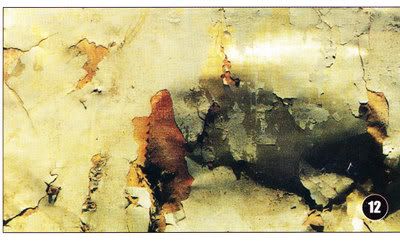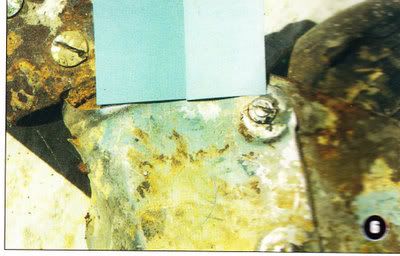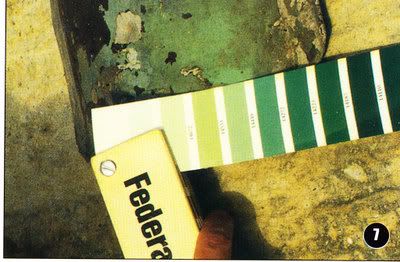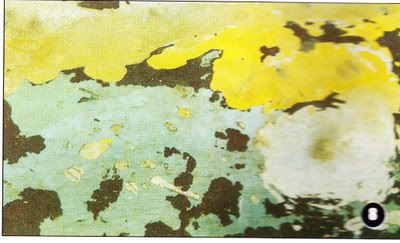When it comes to the upper surfaces of day fighters the camouflage used in 1940 is simple and straightforward. Known as the Land Temperate scheme it consisted of a disruptive pattern of Dark Earth and Dark Green. For the under surfaces things are not so straightforward. Dealing with the specific example first.
P3522/GZ*V appears in a number of publications with the suggestion that the under surface
colour was BS 381 (1930) No 16 Eau de Nil or a similar ‘duck egg green’ colour. (The Hawker Hrricane 1939 to 1945 in RAF, Commonwealth and FFA service, H C Bridgwater, The Battle of Britain Camouflage and Markings 1940 Peter Scott and Gary Madwick.) It is not possible to say definitively what the colour was and some may disagree. It is still possible that Sky or some other substitute colour was used. BS 381 (1930) No 16 Eau de Nil is very similar to Sky, somewhat brighter. The BoBMF’s Hurricane LF363 is currently painted in a scheme that has Eau de Nil as the under surface colour. It is the one with the under surface colour coming up over the leading edges of the wing with a wavy or decaled edge. The man responsible explains.
“I worked out from the time date that LF363 was to be painted to represent that air ministry spec ‘Sky’ had not reached the squadron level and therefore the aircraft was most likely to be in Eau de Nil. There was a lot more research involved by me to be honest, and I obtained a period sample chip of Eau De Nil (1930) which is nothing like the colour in the current BS381c range. I couldn't use the sample to give to the paint company for matching as it was very fragile and had to be returned to its owner but I mixed 10 samples of BS381c range Sky with varying amounts of dark green added in 10cc shots from a syringe. I then sprayed them onto the primer coat chips we were using on the aircraft. Once dry I compared them to the original sample and then sent my chosen sample to the paint company who I am pleased to say matched it perfectly. I later compared the original chip from 60+ years ago to the completed aircraft and other than the glossier sheen on LF363 it was a perfect match.”

In June 1940 the Air Ministry issued orders that day fighters should replace the 50/50 black and white scheme used on the under surfaces and replace it with ca colour called Sky. Sky was new colour in short supply and as a result all sorts of light blue and grey colours were substituted. The story of how the RAF arrived in this situation is an involved one going back to the early days of the war.
By July 1939 there was some concern in Bomber Command about the under surface colouring of its aircraft. The Night under surfaces was felt to make them conspicuous by day against a sky background, and it was by day that most of the flying over enemy territory was envisaged as being carried out. All bombers not definitely allocated to night operations should be painted a colour, or combination of colours, that would make them as inconspicuous as possible against various forms of sky background. If any of these aircraft were required for operations by night, it was thought the under surfaces could easily be blacked over with a temporary matt finish. It was also thought a suitable under surface colour might be silver, light blue, or grey, or some other colour or combination of colours. Despite the unease in Bomber Command no further work was done on under surface camouflage schemes until the outbreak of war in September 1939 brought the activities of Sidney Cotton and the PDU at Heston to the attention of higher authorities.
The PDU had been set up as a result of a meeting at the Air Ministry (AM) on 22nd March 1939, where it was decided to form an experimental unit for the purpose of testing, and if successful, developing novel techniques for photo reconnaissance sorties over enemy territory. The basis of the scheme was the use of high speed and invisibility and the originator of the scheme, Sidney Cotton was put in charge.
The unit’s first equipment was the Bristol Blenheim which was found to be too slow, and with Night under surfaces, too visible from below. A determined effort was made to clean-up the airframe as much as possible and a different, lighter colour was applied to the under surfaces.
Prior to the war, Sidney Cotton had been carrying out clandestine photography while engaged on what were ostensibly legitimate flights over Germany on behalf of the SIS. The aircraft he used was painted a ‘very pale green’ which did not look out of place on a civilian aircraft but happened to be very good at concealing it from observers on the ground. It appears this ‘very pale green colour’ was applied to the under surfaces of the Blenheims at Heston.
Bomber Command evidently heard something of the PDU’s modifications to their Blenheims as, during October, a Blenheim from 139 Squadron was sent to Heston to be modified in a similar manner to those of the PDU. As part of these modifications the Blenheim received the glossy camouflage paints then in use by the PDU, consisting of Dark Earth and Dark Green applied in the usual disruptive pattern on the upper surfaces and what was described as a ‘light sea green’ colour on the under surfaces. This new camouflage must have been reported in some detail to the AM as, during early November, the AM expressed a wish that representatives of the RAE pay a visit to the PDU and give their opinion as to the advantages and disadvantages of the PDU’s camouflage scheme. This resulted in two representatives from the RAE visiting Heston on 18th November 1939.
They found a Blenheim Mk IV had been extensively worked on to eliminate gaps in the skin joints and had been given a very smooth, glossy paint finish with the usual Dark Green and Dark Earth disruptive pattern on the upper surfaces and a colour described in the RAE report as “Duck Egg Green termed Camotint” on its under surfaces. It was claimed that this “Duck Egg Green” finish rendered the aircraft practically invisible at heights of 10,000 ft.
While it had been found that the new smooth finish helped to improve the performance of the Blenheim, it was realised that the glossiness would compromise the camouflage effect. It was therefore requested that the RAE supply Heston with a suitable paint that would match Dark Earth, Dark Green, and Duck Egg Green in colour and would be smoother than the standard camouflage finishes but without the glossiness the dopes currently being used. This request would result in the introduction of Type S finishes.
Bomber Command was most impressed with its streamlined Blenheim on 139 Squadron as, on 25th November 1939, HQ Bomber Command wrote to both the AM and HQ Fighter Command, to inform them that experiments had been carried out at Watton on 139 Squadron Blenheims to clean-up the aircraft with a view to increasing their speed. The experiments were judged to have been a success and it was intended to continue the work on other Blenheim squadrons in the Command.
The letter then stated that coincident with this process a change had been made to the under surface colour of these Blenheims which were now painted what was described as ‘Grey-Blue’ so as to merge into the background of the sky when viewed from below. Bomber Command wished that this change of colouring be brought to the attention of all concerned as the change ws being progressively introduced into Blenheim bomber squadrons; and it would also be necessary to inform the French authorities as these two squadrons of repainted Blenheims were to replace two Fairey Battle squadrons in France in the very near future.
On 29th November 1939 signals A399 and A432 informed No 1 Mission for onward transmission to the French, and all home based forces, that a ‘Light Blue’ colour was being introduced for the under surfaces of Blenheim bombers instead of the present black finish. The AM informed Bomber Command that this had been done in a letter dated 2nd December. The AM approved of the change in colouring and stated that red, white and blue roundels were to be carried on the under surfaces of the wings of aircraft painted in the ‘blue-grey’ colour.
It is not clear exactly what this colour, described in the official correspondence as ‘blue-grey’ and ‘light blue’, actually was. Available photographic evidence suggests that it was much lighter than Medium Sea Grey. Most likely it was Air Ministry Sky Blue. However, there may have been a blue grey colour in use about this time. A ‘Light Blue-Grey’ colour was found on the remains of Hurricane P2728 at Hawkinge which has not been matched to any known standards.
By mid-December, the AM was trying to get such improvements as it could incorporated into Blenheims on the production line. There were, however, problems with the camouflage finish. On 10th January 1940 a meeting was held at the AM to try to get to grips with the problems of introducing two new under surface camouflage materials, one of which was Camotint.
The first problem was the means by which Camotint was obtained. Heston obtained its materials directly from the manufacturer Titanine. When Bomber Command began submitting demands for this material to the AM for use on its day flying Blenheims, nothing was known about it by the Directorate of Engineering. Not being able to obtain supplies of it may have been the reason why Bomber Command used a light blue colour instead.
It was suggested that a technical leaflet might be published giving full instructions regarding the various materials used to obtain the new finish, together with the method of their application, and an AMO (Air Ministry Order) be issued introducing the items for use on all Blenheims. In this connection it was stated that the question of re-painting Blenheim Fighter squadrons was under consideration.
The overriding concern was one of provisioning the new colour. The initial problem was that it needed to be determined exactly what quantities of this new material were required for maintenance purposes on aircraft that were already finished in Camotint, and for re-painting Blenheims held by the ASUs (Aircraft Storage Units) awaiting issue. In the longer term, should the new finish be approved for general use, some estimate of the amount required was needed. At that time samples of Camotint were being prepared by Cellon as an alternative supply to Titanine, but no difficulties were envisaged in obtaining supplies of the new materials from any of the approved paint manufactures.
While this had been going on, work had been put in hand at the RAE to produce a finish employing a very finely ground pigment which it was hoped would give a smooth matt finish. On 25th January 1940, the RAE despatched to Heston, 5 gallons of Dark Earth Type S, 5 gallons of Dark Green Type S, and 20 gallons of Sky Type S. Sky was the name given by the RAE to the ‘duck egg green’ colour known at Heston as Camotint. The suffix Type S was the name given by the RAE to the smooth paint that featured a more finely ground pigment which resulted in a smaller particle size and so smoother finish.
So, by the end of January 1940, the only Sky Type S available was at in the hands of the PDU at Heston, having been supplied in small quantities by the RAE. In February Bristols have appeared to have modified the camouflage scheme of the Blenheims they were producing to have what has been described as ‘light green’ under surfaces. This is understood to have been the first use of Sky on a production aircraft, but this was almost certainly not the new Type S standard; more likely being the same material that Titanine had been supplying to the PDU, a gloss finish to DTD 63A. An eyewitness account suggests that Blenheims built by Bristol at Filton during the early part of 1940, were finished the correct colour Sky, even though the materials used were probably not Type S.
Supporting evidence for this is a letter dated 20th April 1940, sent by the AM to Bristol headed “Camotint – Specification for”. In it, Bristols were told that, “It is agreed that you should call on the schedule for Mod 864 on the Belheim Mk IV for Lacquer to DTD 63 with reduced gloss. The gloss is not to exceed that shown on samples obtained from the Bristol Aeroplane Co Ltd. This degree of gloss is to be permitted on the Blenheim IV only, all other aircraft will comply with the new ‘Type S’ standard. You will arrange with Rootes to supply samples finished with the above DTD 63 with reduced gloss. As regards colour, the pale blue-green which has been called Camotint is now defined as Standard Sky this description should be given in your schedule”.
DTD 63A was then an aircraft finish specification listed in Aircraft Design Memorandum 332, ‘External Finish on Aircraft (issue 2)’dated 8th September 1939. DTD 63A was a Material Specification for Cellulose Enamels and Primers for use on metal or wood which was apparently available in a whole range of colours , including those of the Air Ministry – for example Dark Earth and Dark Green. It was to be suitable for application by brush or spray and originally was to dry to a uniformly smooth covering having a glossy finish. In an amendment dated March 1940, the requirement to dry to a glossy finish was dropped, presumably leading to the finish that the AM referred to as ‘DTD 63A with reduced gloss’ from April onwards.
One specific example where Eau de Nil has been used where Sky was called for was Spitfire P9469 of 222 Squadron coded ZD*T that was lost on 7th October 1940, the remains held by the Robertsbridge Aviation Society.
While there is not trace of the Night and White scheme on the wreckage, it was found to have three layers of paint. The first layer of paint next to the metal appeared on the surface to be an unidentified brown colour. However, when a loose flake of the paint was removed by one of the Society’s members, the side that had been next to metal was found to be an exact match for BSS 381 (1930) No 16 Eau de Nil.
The second layer of paint was a green colour matched to FS 14449. It had a very smooth finish, which while not a full gloss, had some degree of shine. This might be indicative of DTD 63A with reduced gloss.
The top layer of paint matched BSS 381 (1930) No 1 Sky Blue. This is a pale blue with a hint of green which could colloquially be described as ‘duck egg blue’. This was also found to be smooth and shiny indicative of DTD 63A with reduced gloss.
Thus it would appear that P9469 was repainted in service hands at least three times during the summer of 1940 without actually having carrying the right colour.
Hurricane, P2728 was painted with a blue-grey colour that has not been matched any of the known standards. The closest FB 595 match is 35414 but is too dark and too green.
If the RAF could not get supplies of Sky Type S, it would seem the aircraft manufacturers were little better off. While eyewitness accounts suggest that Blenheims built by Bristol in the early part of 1940 were finished Sky, albeit to DTD 63A with reduced gloss, archaeological evidence shows that the colour that was applied to Blenheim under surfaces on the production line at Rootes was not.
The evidence is provided by the remains of Blenheim Mk IV, T2161 of 82 Squadron held by Brenzett Aviation Museum. This particular was built by Rootes and first delivered to the RAF on 10th August 1940, at a time when according to the accepted view; Sky was well established both on the production line and in service. The paint that remains on the wreckage is however, quite unlike the correct shade of Sky, being an excellent match for FS 595B 14533. This is a near match for BSS 381 (1930) Eau de Nil. Once again the finish is very smooth and glossy indicative of materials to DTD 63A with reduced gloss.

Tailwheel and strut from Spitfire Mk I X4325 held at Shoreham Aircraft Museum. The colour matches the standard of the colour Sky Grey.

Fabric covered elevator from an unidentified aircraft held at Brenzett Aeronautical Museum. Dark Earth and Dark Green on the upper surfaces with Sky Grey on the under surfaces. Where the Sky Grey has flaked off the original Aluminium finish is revealed.

Colour matching in progress on tailwheel strut of Spitfire Mk I P9469.held by the Robertsbridge Aviation Society. A good match was found to BS381 (1930) No 1 Sky Blue

Colour matching in progress on another part of P9469. In this case the colour was a rich duk egg green and an excellent match for FS 595B 14449 and a very near match for BS381 (1930) No 16 Eau de Nil.

Close up of a different part of P9469. Both the duck egg blue and rich duck egg green colours can be seen. Both finishes were very smooth and quite glossy. The green had been applied first, over painted later with the blue.
In some cases, individual units mixed their own paint but so far no official documentation has been found on this subject. The Service was advised not to mix materials to DTD 308 with those of DTD 314 to this end. Some idea of the confusion caused by the introduction of Sky Type S is found in the correspondence of Wg Cdr WEB Hurst, then a 22-year-old corporal. He wrote to his wife from his posting in Gloucestershire in August 1940:
"We had to paint some of our kites and for some obscure reason we had to paint them duck egg blue. Why they should choose duck egg blue I can't imagine but ours is not to reason why, so duck egg blue they had to be.
Well, to start with we couldn't get any duck egg blue paint, nobody seemed to have heard of it, so the only thing to do was to mix some. The first thing we had to decide was 'what colour is duck egg blue?'
Nobody knew. Nobody could even remember having seen a duck's egg in the raw, so we were stumped again. Funnily enough nobody but me thought of trying to get hold of a duck's egg from somewhere but somehow my suggestion, that someone should be sent to try and procure one, wasn't received very favourably.
Then we found somebody who remembered having to mix some before. Oh it was a long time ago but he definitely remembered having to mix blue and white paint to the ratio 15:6. Oh good. But was it 15 parts of blue or 15 parts of white? He wasn't sure but thought it was blue. The only thing to do was to try it out and see what it looked like. Well, I should like to see the duck that could lay a beautiful Oxford blue egg! We concluded it must be the other way about, so we mixed a lot more white with it and eventually got about five gallons of a sort of Cambridge blue, which we all agreed a duck's egg might possibly look like! We slapped this on and as it didn't look too bad we left it to dry and went to dinner. When we got back something seemed to have gone wrong for our duck egg blue had dried a beautiful violet! Now this was rather disheartening but it was quite funny to see the Flight Sergeant tearing his hair when he saw it, so we asked him to have a go. He suggested putting more white and some yellow with our mixture. We followed his suggestion and the resulting mixture didn't look too bad, though a bit greenish, but a duck might possibly have been able to produce an egg to match it, so we slapped that over the top of the violet. I don't think it will look too bad when dry but we shan't know the final result until we see it tomorrow. I don't think anyone will dare to open the hangar door in the morning."
In a letter two days later, he wrote:
"We finished duck egg blueing our planes by the way. That first one dried alright and as we had used all the paint on it we had to mix some more and get the right shade. Most of them are a bluey greeney shade, but some of them vary from an almost pea green to almost sky blue!"
BSS 381 (1930) No 1 Sky Blue. Known colloquially as duck egg blue which is a good description of its aquamarine hue. The closest FS 595B match is 14325. The current No 101 Sky Blue is a little darker than the No1 Sky Blue in the 1930 edition. (The numbering system was altered in the 1948 edition.) Available from White Ensign Miniatures (WEM) in their Color Coats range.
BSS 381 (1930) No 16 Eau de Nil). Known colloquially as duck egg green. Its grey/green hue may be described as a rich duck egg green. The closest FS 595B match is 14533. Available from White Ensign Miniatures (WEM) in their Color Coats range.
Sky Blue (Air Ministry) was developed in 1939 by the RAE specifically for use on the undersides of Queen Bee (radio controlled Tiger Moth) drones. The air diagram has a hand written annotation that the colour should look as German as possible. At a meeting on 23rd July 1940, at the Air Ministry, to consider aircraft colourings and markings with a view to achieving the maximum degree of standardization it was decided, subject to agreement by the War Office, that pilotless target aircraft should be issued with duck egg blue (Sky Type S) under surfaces without roundels and that, if necessary, roundels could be painted on by the units themselves.
Sky Blue was one of the colours, along with Azure Blue and Light Mediterranean Blue sanctioned for use on the undersides of aircraft in the Mediterranean and Far East. Applied to the undersides of 151 Wing Hurricanes sent to Murmansk and used on RAF Flying Fortress Mk Is instead of Cosmic (PR Blue) which had been requested by Bomber Command. It is also the chief suspect for the “Light Blue” applied to the under surfaces of Blenheims belonging to the squadrons that were to replace the Fairey Battle Squadrons in France
There is anecdotal evidence and eye witness accounts of fighter aircraft having light blue undersides but it is not possible to say with any certainty what was meant by light blue. There is no reason why Sky Blue could not have been used, unlike the similar looking Azure Blue which had not been invented or named at the time of the BoB, but so far no physical evidence has been found that proves its use.
Other colours that may have been used but for which no physical evidence has been found so far are, Light Mediterranean Blue and BS381 No 28 Silver Grey.